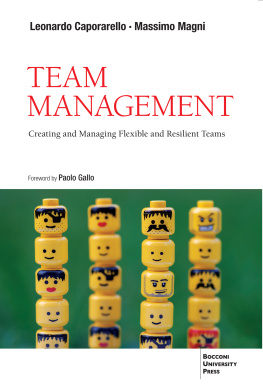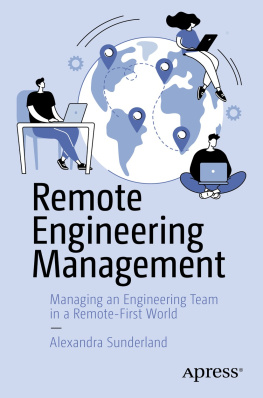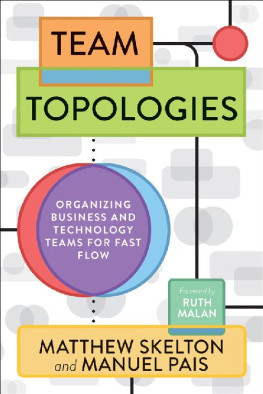TEAM MANAGEMENT
Collaboration and teamwork are the keystones of organizational life. Managing a team requires specific competencies, the outcomes of a process of informed learning based on critical analysis not only of organizational successes, but failures as well. This book provides the tools, the methodology, and the guiding principles to support the people who work in teams as members and as leaders. The main issues inherent to team management are addressed by following a problem-based approach, with the aim of facilitating the achievement of team objectives. The authors encourage readers to reflect on the daily challenges of working on a team, and show how to lay the foundations for building a synergetic team: correctly structuring the team, assigning responsibilities, resolving conflicts, and managing decisions and meetings to optimize negotiation processes. The book also explores the advantages and obstacles to running geographically dispersed teams. Completing each chapter is an interview with an expert who offers answers to the myriad questions that team leaders have to ask themselves to be able to manage their teams with intelligence and common sense.
Leonardo Caporarello is Professor of Practice of Leadership and Negotiation at SDA Bocconi School of Management, where he is also Deputy Dean for Lifelong Learning. He is also the Rectors Delegate for e-learning at Bocconi University and Director of BUILT (Center for Teaching Innovation) at the same University.
Massimo Magni is Associate Professor of Business Organization in the Department of Management and Technology at Bocconi University and Director of the Master of Science in International Management at the same University. He is also Faculty Deputy of the Knowledge Group Leadership, Organization & Human Resources at SDA Bocconi School of Management.

Leonardo Caporarello Massimo Magni
TEAM MANAGEMENT
Creating and Managing Flexible and Resilient Teams
Foreword by Paolo Gallo
Cover: Cristina Bernasconi, Milan
Typesetting: Laura Panigara, Cesano Boscone (MI)
Copyright 2022 Bocconi University Press
EGEA S.p.A.
EGEA S.p.A.
Via Salasco, 5 - 20136 Milano
Tel. 02/5836.5751 Fax 02/5836.5753
All rights reserved, including but not limited to translation, total or partial adaptation, reproduction, and communication to the public by any means on any media (including microfilms, films, photocopies, electronic or digital media), as well as electronic information storage and retrieval systems. For more information or permission to use material from this text, see the website www.egeaeditore.it
Given the characteristics of Internet, the publisher is not responsible for any changes of address and contents of the websites mentioned.
First edition: July 2022
ISBN Domestic Edition 978-88-99902-99-5
ISBN International Edition 978-88-31322-57-7
ISBN Digital Domestic Edition 978-88-238-8465-6
ISBN Digital International Edition 978-88-31322-58-4
Table of Contents
Foreword
by Paolo Gallo
If you have seen him live in concert you will remember him all your life. Yes, of course, Im talking about the Boss, Bruce Springsteen. Towards the end of all his concerts, which last at least three hours, Bruce sings-recites a kind of gospelusually standing on the piano: I wanted to be the rock n roll apostle of this planet, then I had a vision... an Angel told me Son, you need a Band, you cant do it alone. The moments that follow are simply exhilarating. Bruce not only introduces his musicians to the audienceor rather to the faithful devotees who attend a collective rite of joy, sweat and tears he does so with esteem, love and friendship. They have been playing together (playing in every sense! You can tell theyre having a great time) for 45 years. Bruce also remembers, always with respect and gratitude, the two musicians who are no longer with us, Danny on the keyboard, and the beloved saxophonist Clarence: it is a very moving moment. Admiring how he presents his band, you understand that Bruce has become a loved and respected planetary icon also thanks to his musicians, the famous E Street Band. I confess that Ive come to understand the importance of the team thanks to the concerts Ive attended (74 since 1985 until today), but for years I didnt understand the tools and methodologies needed to manage one: not as a rock star (I would have liked that, as you can imagine), but as Director of Personnel in various international organizations in London, Washington and Geneva.
Magni and Caporarellos book, for which I have the honor of writing the foreword to this third edition, provides the tools, methodology and principles for managing a team with intelligence and common sense. A real why & how guide, written in an exemplary, clear and useful way.
We realized that we cant achieve certain goals and objectives on our own, so we need to work with and collaborate with others. Yes, but how? Intuitively we know that we need a band, a team that we are a part of, too. Even if we were to become CEO of a company wed never be alone at the helm; wed always need others. Why? First of all because the problems we have to manage are not only complicated but also complex. The difference between the two terms is not simply semantic, but goes deeper. A complicated problem requires technical expertise in order to solve it; a complex problem, on the other hand, requires technical expertise, but also collaboration between people and the ability to manage the tensions and conflicts that could arise, as well as the ability to use a systemic, non-linear approach.
This book takes us on a journey made up of steps, all of which are fundamental. How do you create a team? How do you structure it? How do you define the roles within it? How do you make decisions? These are not trivial questions. I must confess that many managers (including myself at the beginning of my career) do not know how to ask themselves these questions. In my experience Ive noticed how managers fight like lions to get extra people on their team but then dont really know how to get the best out of them. Can I make a suggestion? Ask yourself this question, If 100% is your potential, how much of it are you using in your work? Typically the average is around 65/70%, leaving plenty of room to better utilize peoples potential.
This book also answers other important questions too: How should I manage conflict? What are the causes? Is the conflict related to the role or personality of team members? When and how should the leader intervene?
I think the pages on conflict are must-reads, essential to our professional growth. There will always be conflict, and in some ways thats a good thing. For this reason, it should not be repressed, ignored or delegated. I dont know how many times Ive heard, this is a problem that needs to be handled by the chief of staff. Glaring red-pencil error. Conflict needs to be taken into account, dealt with, and it can also be a source of enrichment by virtue of the diversity of views on the team (it sounds strange but it is).
The book then proceeds in the right direction by asking: How do you negotiate among team members? It certainly could not miss the analysis on how to manage a geographically dispersed team, and thus answer the question: How can you develop a system of trust instead of control systems? During the pandemic, we experienced first-hand how a virtual meeting is not the same as a face-to-face meeting.









